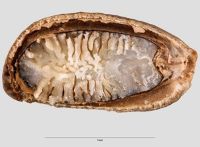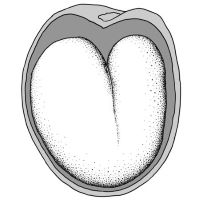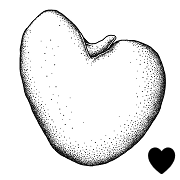Content is from Kirkbride et al. 2006Kirkbride et al. 2006:
Kirkbride JH, Jr, Gunn CR, and Dallwitz MJ. 2006. Family guide for fruits and seeds, vers. 1.0. Accessed September 2020-January 2022. URL: https://nt.ars-grin.gov/seedsfruits/keys/frsdfam/index.cfm ., without modification.
Updates are forthcoming.
Aextoxicaceae A. Engler & E. Gilg
Common name: Aetoxicon Family.
Number of genera: 1 genus.
Number of species (Mabberley 1997): 1 species (Aetoxicon punctatum Ruiz & Pavon).
 and mesocarpmesocarp:
and mesocarpmesocarp: absent and endocarpendocarp:
absent and endocarpendocarp: exposed.
exposed.
Fruits: Pistil(s) 1; 1-pistillate. Fruit pericarpium; simple; nuculanium (Cronquist: dry drupedrupe:
(indehiscent drupe) a fleshy, indehiscent fruit with one more hard pits enclosing seeds, derived from single, superior, simple or compound ovary; (dehiscent drupe) a fruit with a dry or fibrous to fleshy or leathery outer husk that early to tardily breaks apart (or opens), exposing one or more nutlike pits enclosing the seeds ); without persistent central column; not within accessory organ(s); 1-seeded; with 2-carpellate; with carpels united; with carpels remaining united at maturity; with carpels remaining connected at stylestyle:
); without persistent central column; not within accessory organ(s); 1-seeded; with 2-carpellate; with carpels united; with carpels remaining united at maturity; with carpels remaining connected at stylestyle:
in a flower, the narrow and elongated part of the pistil between the stigma and the ovary; sometimes persisting in fruit ; without sterilesterile:
; without sterilesterile:
lacking male and/or female reproductive parts; also, not producing fruit or seed
 carpels; not sulcatesulcate:
carpels; not sulcatesulcate:
surface relief—having one or more elongate, relatively narrow and shallow depressions or grooves ; indehiscentindehiscent:
; indehiscentindehiscent:
not opening on its own, as in a fruit
 . Epicarpepicarp:
. Epicarpepicarp:
outer layer of fruit wall or pericarp, if divided into layers; note here used synonymously with exocarp durable; without armature; without wing(s); without apicalapical:
durable; without armature; without wing(s); without apicalapical:
at or pertaining to the end of the seed or fruit distal from its point of attachment (i.e., base)
respiratory hole. Mesocarpmesocarp:
the middle layer of the pericarp, if divided into layers present. Endocarpendocarp:
present. Endocarpendocarp:
the inner layer of the pericarp, if divided into layers present; not separating from exocarpexocarp:
present; not separating from exocarpexocarp:
outer layer of fruit wall or pericarp, if divided into layers; note here used synonymously with epicarp ; thin, or hard; not splitting into 1-seeded pyrenes; stone unilocular; stone 1-loculate; without operculumoperculum:
; thin, or hard; not splitting into 1-seeded pyrenes; stone unilocular; stone 1-loculate; without operculumoperculum:
a dehiscent cap (or lid) of a seed or fruit that opens during germination or dehiscence ; without secretory cavities; without longitudinallongitudinal:
; without secretory cavities; without longitudinallongitudinal:
of or relating to length or the lengthwise dimension
ridges. Funiculusfuniculus:
(alt. funicle) stalk connecting the ovule (later seed) to the ovary (later fruit) placenta short; short without seed bearing hookswith hooks:
short; short without seed bearing hookswith hooks:
bristles or spines with curved or backwards pointing tips, or with secondary bristles along their length (retinacula); not persisting in fruit after seed shed.
(retinacula); not persisting in fruit after seed shed.
Seeds: Arilaril:
(broad sense) appendicular structure that wholly or partly envelops a seed and is produced from or a modification of the funicle, raphe, or outer integument; usually fleshy or pulpy, sometimes spongy or tufted-capillate, often brightly colored absent. Seed larger than minute; not bowl shaped; not nutlike; without winglike beakbeak:
absent. Seed larger than minute; not bowl shaped; not nutlike; without winglike beakbeak:
a usually firm, terminal appendage, sometimes tapered ; without caudatecaudate:
; without caudatecaudate:
tapering to a long, tail-like appendage appendage(s); at maturity with food reserves; with endosperm; without canavanine. Sarcotestasarcotesta:
appendage(s); at maturity with food reserves; with endosperm; without canavanine. Sarcotestasarcotesta:
pulpy or fleshy outer layer of the seed coat, simulates aril absent. Testatesta:
absent. Testatesta:
seed coat
 present; without fleshy or leatheryleathery:
present; without fleshy or leatheryleathery:
texture—moderately thick, tough, and very pliable
layer over hard layer; surface unsmooth; surface with merged raised features; surface reticulatereticulate:
surface relief—netted, raised walls or concave grooves forming a net-like surface pattern with flat, concave, or convex interspaces ; without crease or line separating cotyledons from hypocotyl-radicle; without notch along margin where cotyledons from hypocotyl-radicle tip approach each other; without glands; without bristles; without wings; without collar; without operculumoperculum:
; without crease or line separating cotyledons from hypocotyl-radicle; without notch along margin where cotyledons from hypocotyl-radicle tip approach each other; without glands; without bristles; without wings; without collar; without operculumoperculum:
a dehiscent cap (or lid) of a seed or fruit that opens during germination or dehiscence ; colored; monochrome; not becoming mucilaginousmucilaginous:
; colored; monochrome; not becoming mucilaginousmucilaginous:
resembling mucilage; moist and sticky
when wetted; surrounding food reserve. Endosperm copious; fleshy-firm; ruminateruminate:
testa or seed coat folded into the endosperm ; without fatty acid containing cyclopropene; without apicalapical:
; without fatty acid containing cyclopropene; without apicalapical:
at or pertaining to the end of the seed or fruit distal from its point of attachment (i.e., base)
lobes; without chlorophyll; without isodiametric faceted surface; without odor. Embryo differentiated from food reserve; well developed; 1 per seed; partially filling testatesta:
seed coat
 (with food reserve); 0.5 times the length of food reserve; at one end of seed not extending into a depression or cup; axileaxile:
(with food reserve); 0.5 times the length of food reserve; at one end of seed not extending into a depression or cup; axileaxile:
on or of the axis
and centric; foliatefoliate:
appearing leaf-like
; bentbent:
(of embryo) embryo is bent at an acute, V-shaped angle with the ends close together and generally thick cotyledons ; without coleorhiza; without simmondsin; without stomata; not green; with 2 or more cotyledons. Cotyledons 2; well developed; 0.6 times length of embryo; somewhat to significantly wider than hypocotyl-radicle; 4 times wider than hypocotyl-radicle; flat; smooth; basally cordatecordate:
; without coleorhiza; without simmondsin; without stomata; not green; with 2 or more cotyledons. Cotyledons 2; well developed; 0.6 times length of embryo; somewhat to significantly wider than hypocotyl-radicle; 4 times wider than hypocotyl-radicle; flat; smooth; basally cordatecordate:
2D shape—heart-shaped, with attachment at or near the broad end (compare obcordate) ; equal in size; not punctatepunctate:
; equal in size; not punctatepunctate:
surface relief—dotted with pits or with translucent, sunken glands or with colored dots, similar to pitted dotted. Hypocotyl-radicle well developed; curvedcurved:
dotted. Hypocotyl-radicle well developed; curvedcurved:
(of embryo) linear embryo is curved into an arch or horseshoe with the ends far apart (somewhat); not thickened.
(somewhat); not thickened.
General references: Corner, E.J.H. 1976. The seeds of Dicots, esp. vol. 2. Cambridge University Press, New York, Cronquist, A. 1981. An integrated system of classification of flowering plants, 1,262 p. Columbia University Press, New York, Goldberg, A. 1986 (dicots) & 1989 (monocots). Classification, evolution, and phylogeny of the familes of Dicotyledons. Smithsonian Contr. Bot. 58 for dicots (314 pp.) & 71 for monocots (74 pp.). [Goldberg's illustrations are reproduced from older publications and these should be consulted], Gunn, C.R., J.H. Wiersema, C.A. Ritchie, & J.H. Kirkbride, Jr. 1992 & amendments. Families and genera of Spermatophytes recognized by the Agricultural Research Service. Techn. Bull. U.S.D.A. 1796:1–500, Mabberley, D.J. 1987. The plant-book, 706 p. Cambridge University Press, Cambridge, and Spjut, R.W. 1994. A systematic treatment of fruit types. Mem. New York Bot. Gard. 70:1–182.